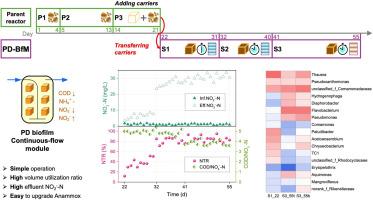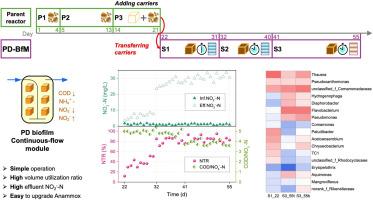Establishment of continuous flow partial denitrification biofilm module with short hydraulic retention time
IF 11.4
1区 环境科学与生态学
Q1 ENGINEERING, ENVIRONMENTAL
引用次数: 0
Abstract
Partial denitrification (PD) can supply essential nitrite (NO2-) and is supposed to promote the application of Anammox. However, PD-related research mainly involves sequencing batch reactors and activated sludge. Here, we proposed establishing PD in a continuous-flow submerged biofilm module (PD-BfM). Benefiting from employing anoxic starvation treatment to quickly start PD and transferring enriched functional bacteria onto biofilms in time, the preparation work of PD-BfM was completed within a quite short period of 21 days. With the hydraulic retention time adjusted to 50 min, PD-BfM demonstrated an impressive efficiency in generating NO2-, achieving a nitrate-to-nitrite transformation ratio of over 75 %, even at the influent chemical oxygen demand to nitrate ratio of 4 condition. Meanwhile, the dominant genus in the biofilms was shifted from Thauera to Flavobacterium and Comamonadaceae family members. The gradient of substrate concentrations also possibly differentiated microbial communities between the top and bottom bio-carriers.


建立水力停留时间短的连续流部分脱硝生物膜模块
部分反硝化(PD)可提供必要的亚硝酸盐(NO2-),并可促进 Anammox 的应用。然而,与部分反硝化相关的研究主要涉及序批式反应器和活性污泥法。在此,我们建议在连续流浸没式生物膜模块(PD-BfM)中建立 PD。利用缺氧饥饿处理快速启动 PD,并及时将富集的功能菌转移到生物膜上,PD-BfM 的准备工作在很短的 21 天内完成。当水力停留时间调整为 50 分钟时,PD-BfM 在生成 NO2- 方面表现出了惊人的效率,即使在进水化学需氧量与硝酸盐比值为 4 的条件下,硝酸盐与亚硝酸盐的转化率也超过了 75%。同时,生物膜中的优势菌属也从 Thauera 菌转为黄杆菌和 Comamonadaceae 菌。底物浓度梯度也可能区分了顶部和底部生物载体的微生物群落。
本文章由计算机程序翻译,如有差异,请以英文原文为准。
求助全文
约1分钟内获得全文
求助全文
来源期刊

Water Research
环境科学-工程:环境
CiteScore
20.80
自引率
9.40%
发文量
1307
审稿时长
38 days
期刊介绍:
Water Research, along with its open access companion journal Water Research X, serves as a platform for publishing original research papers covering various aspects of the science and technology related to the anthropogenic water cycle, water quality, and its management worldwide. The audience targeted by the journal comprises biologists, chemical engineers, chemists, civil engineers, environmental engineers, limnologists, and microbiologists. The scope of the journal include:
•Treatment processes for water and wastewaters (municipal, agricultural, industrial, and on-site treatment), including resource recovery and residuals management;
•Urban hydrology including sewer systems, stormwater management, and green infrastructure;
•Drinking water treatment and distribution;
•Potable and non-potable water reuse;
•Sanitation, public health, and risk assessment;
•Anaerobic digestion, solid and hazardous waste management, including source characterization and the effects and control of leachates and gaseous emissions;
•Contaminants (chemical, microbial, anthropogenic particles such as nanoparticles or microplastics) and related water quality sensing, monitoring, fate, and assessment;
•Anthropogenic impacts on inland, tidal, coastal and urban waters, focusing on surface and ground waters, and point and non-point sources of pollution;
•Environmental restoration, linked to surface water, groundwater and groundwater remediation;
•Analysis of the interfaces between sediments and water, and between water and atmosphere, focusing specifically on anthropogenic impacts;
•Mathematical modelling, systems analysis, machine learning, and beneficial use of big data related to the anthropogenic water cycle;
•Socio-economic, policy, and regulations studies.
 求助内容:
求助内容: 应助结果提醒方式:
应助结果提醒方式:


